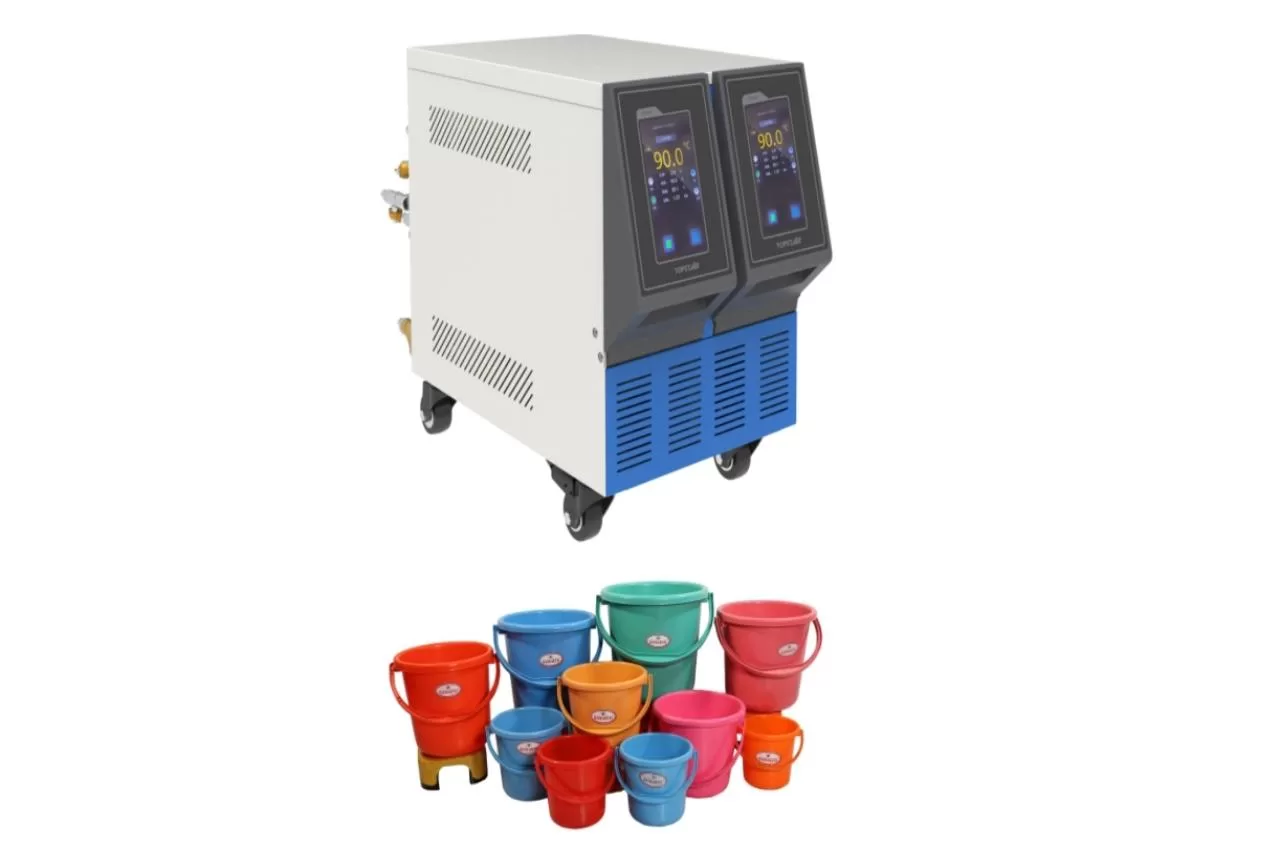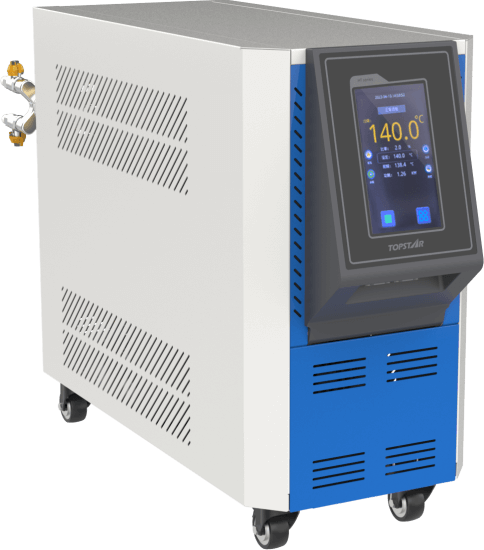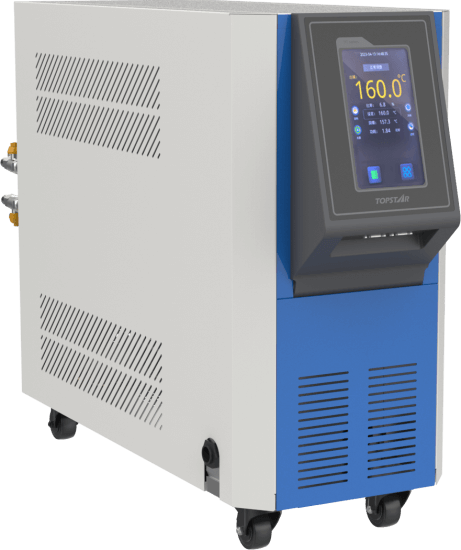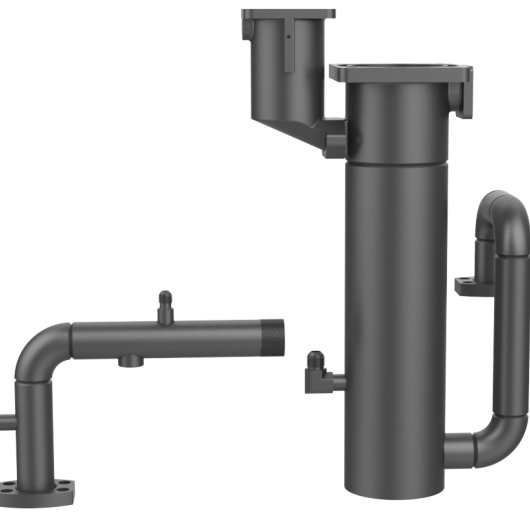What type of mold temperature controller is used in Plastic bucket manufacturing?
2024/08/05 By Topstar

In Plastic bucket manufacturing, a series of injection molding equipment is involved, including injection molding machines, mold temperature controllers, chillers, dryers, etc. Through the mutual compatibility between these equipment, a closed-loop production system is formed. Temperature control is critical during the entire process of injection molding plastic buckets. If you cannot maintain a suitable temperature, the final product will suffer from quality problems. Therefore, a mold temperature controller is needed in the manufacture of plastic buckets to keep the mold temperature at an optimal level, thereby producing high-quality plastic buckets.
The role of mold temperature controller in plastic bucket manufacturing
The mold temperature controller can keep the mold within a consistent and precise temperature range. The consistent temperature can ensure that the plastic material flows into the mold evenly, thereby producing a bucket with uniform thickness and complete structure. If you do not control the mold temperature well, problems such as warping, shrinkage, and poor surface finish will occur, affecting the quality of the final product.
Their working principle is to circulate a heat-conducting fluid (such as water or oil) in the mold, and the fluid will absorb or dissipate heat as needed to maintain the required temperature. Based on temperature PID algorithm control, they control temperature accuracy at ±0.1℃ to ensure temperature uniformity and have an over-temperature protection mechanism to ensure the yield of plastic products.
Water-Based Mold Temperature Controllers
Water-based mold temperature controllers utilize water as a heat transfer medium and maintain the moderate temperatures typically required in plastic injection molding processes. Water has excellent thermal conductivity, allowing it to absorb and dissipate heat quickly. The highest temperature range for water-based mold temperature controllers in Topstar is in the 120°C-180°C range. Because water is readily available, they are easier to maintain and operate than oil-based systems. In addition, they are using water as a medium, which is more environmentally friendly and does not require special process treatment.

Oil-based mold temperature controller
Some large plastic bucket manufacturers choose oil-based mold temperature controllers when they require higher mold temperatures. These systems use oil as a heat transfer medium, and the operating temperature is much higher than that of water-based systems, with a maximum temperature range of 200°C-320°C.
Due to the characteristics of oil, they require careful handling and maintenance. Topstar’s oil-based mold temperature controllers will detect the oil tank level and add oil shortage alarm protection better to maintain high temperatures and stable temperature control capabilities. The specific requirements of the manufacturing process, including the type of plastic used and the desired properties of the final product, often determine the choice between water-based and oil-based machines.

Different performance characteristics
Topstar’s mold temperature controllers are different from traditional machines on the market in that they are more intelligent, so the 7-inch touch screen is different from the button control on the market. They can more intuitively display the working status of the mold temperature controller, making it easier to operate. They also support booking the machine on and off one week in advance, which is convenient for customers to manage production schedules. In addition, they also use the RS485 communication interface and support MODBUS RTU communication protocol, which can help customers realize multi-machine communication interconnection, which is conducive to customers making future overall planning and facilitating data collection.
The service life is also longer than that of other mold temperature controllers on the market. The whole machine uses stainless steel as the frame for integrated casting and modular integrated design to reduce the risk of joint leakage and increase the life of the mold temperature controller. To meet different needs, select water quality filters to reduce pipeline blockage and shutdown failures caused by water quality problems, thereby ensuring the continuity of production.

Choose according to your needs
Choosing a mold temperature controller suitable for plastic bucket manufacturing requires a thorough understanding of your specific production needs and requirements. Factors to consider include the type of plastic material used, the required mold temperature, and the desired characteristics of the final product. In Topstar, the temperature range of water-type mold temperature controllers is 120℃-180℃, and the range of oil-type mold temperature controllers is 200℃-320℃. For most plastic barrels, water-type mold temperature controllers are able to meet the required temperature and provide an efficient and cost-effective solution. However, if the process requires a higher mold temperature, an oil system may be necessary.
Understanding the different types of mold temperature controllers and their respective advantages can help us make the correct choice. Smarter, safer and more reliable performance, and more reasonable structure can improve product quality, shorten cycle time and achieve energy saving.
TRENDING POSTS
- What factors can cause delays in the injection molding process of plastic molding machine? 2024/08/05
- Exhibition Review| Topstar participates in InterPlas Thailand 2024 2024/08/05
- Star Case | Topstar helps Santong upgrade its intelligent plant 2024/08/05
- Topstar Special | National Science and Technology Workers Day 2024/08/05
HOT TOPIC
- 3 in 1 Compact Dehumidifying Dryer
- 5-axis CNC machine
- accuracy
- Air Chillers
- all electric injection molding machine
- All-electric injection molding machines
- and overall production quality. Therefore
- AP-RubberPlas
- automated injection molding machine
- Automation changed engineering
- automation of injection molding robots
- auxiliary machine
- Bench Injection Molding Machine
- Cabinet dryer manufacturers
- Cabinet dryers
- chiller
- CNC Drilling Machine
- CNC Drilling Machines
- cnc engraving machine manufacturer
- cnc laser cutting machine manufacturer
- CNC machine
- CNC Machine Center
- CNC Machine for Sale
- CNC Machine Manufacturing
- CNC Machine Tool
- CNC machine tool product
- CNC Machining Center
- CNC wood carving machine
- Cooling system
- Cross-Walking Single Axis Servo Cylinder Robot
- Cross-Walking Single-Axis Servo Cylinder Robot
- Cross-Walking Three-Axis/Five-Axis Servo Driven Robot
- cross-walking three-axis/five-axis servo-driven robot
- Dehumidifier Dryer
- Dehumidifying Dryer
- delta parallel robot
- Desktop Injection Molding Machine
- Desktop injection molding machines
- Desktop Molding Machine
- desktop plastic injection machine
- Desktop Plastic Injection Molding Machine
- direct clamp injection molding machine
- Direct clamp injection molding machines
- Dosing & mixing system
- Drilling Centers
- Drying and dehumidification system
- drying and dehumidifying equipment
- Drying and Dehumidifying System
- drying system
- effective and efficient. Cabinet dryers are also used in other industries where large quantities of material need to be dried
- efficient injection molding machine
- elbow hydraulic injection molding machines
- electric injection molding machine
- electric injection molding machines
- etc. Among injection molding robots
- exhibition
- features of CNC machine
- Feeding And Conveying System
- Five Axis Machine Center
- Fully automatic injection molding machine
- Gathering Topstar
- giant injection molding machine
- GMU-600 5-Axis Machining Center
- Granulating & Recycling System
- Heavy duty injection molding machine
- Honeycomb rotor dehumidifier
- horizontal injection molding machine
- Horizontal Injection Molding Machines
- Horizontal Injection Moulding Machine
- Horizontal Mixer manufacturer
- How The CNC Machine Works
- hybrid injection molding machine
- hydraulic injection molding machine
- Hydraulic Injection Molding Machines
- in this article
- Industrial robot
- Industrial Robot Chinese brand
- industrial robot parts
- industrial robot supplier
- Industrial robots
- Industry Chain
- Injection Manipulator
- injection mold machines
- Injection molding
- Injection molding automation
- Injection Molding Automation Solution
- injection molding dryer
- Injection molding equipment
- injection molding hopper dryer
- Injection molding machine
- injection molding machine brand
- Injection Molding Machine Factory
- Injection Molding Machine Manufacture
- Injection molding machine manufacturer
- injection molding machine manufacturers
- Injection molding machine procurement
- injection molding machine robotic arm
- injection molding machine with a robot
- Injection molding machines
- injection molding material dehumidifying
- injection molding plant
- Injection Molding Robot
- injection molding robot arm
- Injection molding robot automation
- Injection molding robotic arm
- injection molding robots
- Injection Moulding Robots
- Injection Robot
- Injection robot arm
- Injection robot manufacturer
- Injection robot wholesale
- injection robots
- intelligent injection molding machines
- Introducing Injection Robot
- It is the best choice for drying large quantities of material at once. Cabinetmakers use these machines because they are fast
- large injection molding machine
- Learn what industrial automation and robotics is
- low speed sound-proof granulator
- machine plastic molding
- make sure to add some! Improvements (2) Keyphrase in introduction: Your keyphrase or its synonyms appear in the first paragraph of the copy
- manipulator machine
- manufacturing
- micro injection molding machine
- middle speed granulator
- Mini CNC machine manufacturers.
- Mold Temperature Control System
- mold temperature controller
- molding material Dehumidifying System
- mould temperature controller
- mould temperature controllers
- New electric injection molding machine
- nitrogen dryer manufacturer
- nitrogen dryer system manufacturer
- Oil type mold temperature controller
- open day
- Outbound links: No outbound links appear in this page. Add some! Images: No images appear on this page. Add some! Internal links: No internal links appear in this page
- PET Preform injection molding
- phone case maker machine
- phone case making machine
- plastic bottle making machine
- plastic bottle manufacturing
- plastic bucket making machine
- plastic bucket manufacturing
- Plastic chair making machine
- plastic forming equipment
- plastic hopper dryer
- plastic injection machine
- plastic injection machines
- plastic injection molding
- Plastic injection molding equipment
- Plastic injection molding machine
- Plastic Injection Molding Machines
- plastic injection robot
- Plastic Molding machine
- Plastic Molding Machines
- plastic molding press
- plastic phone case making machine
- plastic-molding machine
- powerful granulator
- Powerful Type Sound-Proof Granulator
- production of plastic seats
- Robot injection molding
- robot injection molding machine
- robot manufacturing companies
- Robotic arm for injection molding machine
- robotic injection molding machines
- robotics in injection molding
- SCARA robot
- SCARA robots
- Service-oriented manufacturing
- Servo Cylinder Robot
- servo driven robot
- Servo Driven Robots
- servo injection robots
- Servo-Driven Robot
- Setup of injection machine
- Silicone Injection Molding Machine
- six-axis industrial robot
- Stainless Hopper Dryer
- Stainless Hopper Dryers
- star club
- swing arm robot
- the choice between servo-driven robots and hydraulic robots will have a certain impact on efficiency
- the most popular injection molding machine
- the type of injection molding robot
- toggle clamp injection molding machine
- Toggle Hydraulic Injection Molding Machines
- toggle injection molding machine
- Top 10 brands of injection robots
- Topstar
- Topstar Engineering
- Topstar Industrial Robots
- Topstar injection molding intelligent
- Topstar Scara Robots
- Useful Injection molding machine
- Vertical machining centers
- volumetric type blender
- water chiller
- water chillers
- water distributor
- Water Type MoldTemperature Controller
- We often face choices when performing injection molding. We will choose the type of injection molding machine
- wholesale of injection molding machines
- x carve CNC
